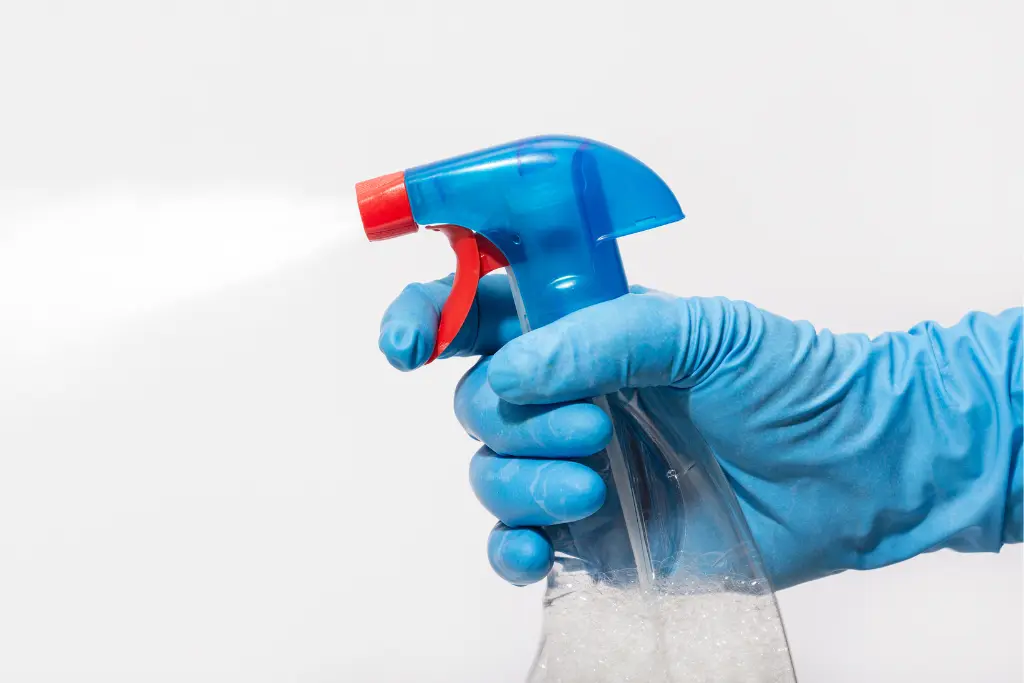Getting blood out of an office chair can be tricky but not impossible. Blood stains are difficult to remove because blood contains iron which binds strongly to fabric fibers. However, with the right cleaning technique and products, you should be able to lift blood stains from your office chair and get it looking as good as new. This guide will provide you with simple, effective methods to get blood out of an office chair so it is no longer noticeable. By the end, you will be able to understand how to get blood out of office chair.
What Causes Blood on Office Chairs
Before learning how to remove blood from office chairs, it helps to understand the common causes behind these stains. Here are some of the most frequent reasons you may find blood on an office chair:
- Nosebleeds – Frequent nosebleeds can cause small drops of blood to drip onto an office chair. Nosebleeds are often triggered by colds, allergies, or even just picking your nose.
- Menstruation Leaks – Unexpected leakage from a woman’s menstrual cycle can transfer blood onto the seat of an office chair. This is an unavoidable nuisance that half the population deals with monthly.
- Wounds/Injuries – Open wounds anywhere on the body can fling small specks of blood onto surrounding furniture. This may occur from paper cuts, scraped knees, or other minor injuries.
- GI Bleeding – Those dealing with gastrointestinal issues like ulcers, hemorrhoids, or other conditions may unknowingly get blood from these sources onto an office chair.
No matter how the blood got onto the office chair, it’s important to take action quickly. Over time, blood stains can set and become increasingly stubborn to remove
Why You Should Act Quickly
When any liquid or substance gets spilled on a fabric, it is best to attend to it as soon as possible for the best chances of complete removal. The same applies for blood stains. The longer blood is left on the fabric, the more it will set into the fibers and the harder it will be to lift out. Within the first few minutes of a spill, the blood components have not yet had time to fully bond to the fabric.
Acting fast while the stain is still fresh gives you a much better shot at a successful clean. After just 30 minutes, the blood proteins will start clinging tighter to the chair fabric. So get started if you want the best results. Start treating the stain immediately for an easier cleanup.
Choosing The Right Cleaning Agent
There are a few different products that work well for removing blood from office chair fabrics. Here are some wise choices to keep available:
- Hydrogen Peroxide: The active ingredient in hydrogen peroxide is oxygen, which helps break down the iron in the blood. Pour hydrogen peroxide directly onto the stained area and let it bubble for a few minutes before blotting. This process helps lift the blood out of the fibers.
- Dish Soap: The degreasing properties of dish soap make it effective for lifting out oily substances like blood. Make a soapy solution by mixing a few drops of liquid dish soap with water in a spray bottle. Spray the soapy water directly onto the stain and let it dwell before wiping it away.

- Cold Water: For fresh blood stains, cold water alone may do the trick. As long as you act quickly, use a clean cloth or paper towel dampened with cold water to dab at the blood spot, lifting it out fiber by fiber.
- Enzyme-Based Cleaner: Look for a cleaner that contains protease enzymes designed to break down protein-based stains like blood. Spray or dab the enzyme cleaner directly onto the stain and allow it to work its magic before lightly blotting.
Trying different cleaning agents on an inconspicuous area of the chair fabric first is always a good idea to check for color fastness before treating the full stain. With quick action and the right product, you can easily get blood out of office chair fabric.
The Basic Blood Removal Process
Now let’s go through the step-by-step procedure for how to remove dried blood from office chair fabric:
- Prep the Area: Work in a well-ventilated space, put on gloves and lay down towels or old sheets beneath the chair to catch any moisture. You don’t want fluids dripping onto other surfaces.
- Lift Surface Dried Blood: Use a dull butter knife or plastic utensil to gently scrape away any surface-level dried blood flakes. This makes the stain easier to penetrate with liquid cleaners.
- Blot and Dab: Saturate the stain with cold water and blot the area with a light-colored towel or absorbent cloth. Blot, don’t rub! Repeating this process draws up deep blood residue without spreading it around.

- Make a Pre-Treat Paste: Mix a couple of tablespoons each of dish soap (like Dawn), hydrogen peroxide, and baking soda to form a paste. Spread liberally over the stain and let sit for 10-15 minutes before dabbing dry with a towel.
- Rinse and Check the Progress: Wet the area again with fresh water and check if the stain has lifted yet. Keep blotting until the water runs clear. You may need to repeat steps 3-5 for stubborn blood marks.
- Use Enzymatic Cleaner: If the spot persists, apply a stain remover with enzymes designed for protein such as activated oxygen or enzyme-based spotters. Check label directions for application, then soak and rinse.
- Treat With Bleach: Bleach can be highly effective against set-in blood but also very harsh. Dilute 1 part bleach with 9 parts water for light-colored fabrics. Spot test first and avoid bleach on dark materials where it may cause discoloration. Always rinse well after with fresh water.
- Dry in Sunshine: Allow the chair to fully air dry in direct sunlight if possible, which contains natural stain-lifting UV light rays. Sunlight is a powerful antibacterial agent too. No sun? An extra rinse won’t hurt.
Related: How to Clean Office Chair Smell – A Comprehensive Guide
- Repeat as Needed: It may take a few rounds of treatments to fully lift dried blood stains that have had time to bond to the fibers. Be patient and don’t give up after just one try. Consistency is key to success.
Cleaning Blood From Office Chair Upholstery
The cleaning method used to remove blood from an office chair depends on the type of upholstery. From woven fabric to leather and vinyl, each material requires a tailored approach.
Fabric Office Chairs
Woven office chair upholstery offers a porous surface that allows liquids to seep deep into the fibers. Follow this systematic process to lift blood from fabric office chairs:
- Blot up excess blood immediately using a clean, dry towel. Avoid scrubbing or wiping the stain, as this can further embed the proteins.
- Rinse the stained area with cold water to dilute any remaining residue. Use a wet towel or spray bottle to apply the water.
- Make a diluted dish soap solution of 1-2 tsp dish soap per 1 cup of cold water. Use a clean sponge or towel to gently scrub the soapy solution into the stain.
- Rinse the area thoroughly with fresh cold water. Blot dry with a towel. Avoid harsh rubbing.
- If any hint of the stain remains, make a diluted hydrogen peroxide solution – 1 part peroxide to 2 parts water. Spray or sponge this over the stain. Wait 10-15 minutes before rinsing.
- Blot dry and allow the chair to fully air dry before using. The peroxide may take a day or two to fully lift the blood residue.
Leather and Vinyl Office Chairs
Leather and vinyl office chairs provide an impermeable barrier that keeps blood from penetrating the chair interior. Use the following steps for non-porous upholstery:
- Gently blot excess blood immediately with a dry, soft cloth. Avoid any scrubbing or wiping side-to-side.
- Mix cold water and a small amount of dish soap. Use a soft bristle brush dipped in the solution to gently brush the surface of the stain. Avoid scrubbing aggressively.

- Rinse the area with fresh cold water and blot dry with a microfiber towel. Take care not to soak the surrounding upholstery.
- If needed, use a specialized leather cleaner to break up any remaining residue. Use a small amount on a damp cloth in gentle, circular motions.
- Rinse with clean water and pat dry with a fresh towel once the blood is removed. Before using the chair again, allow it to completely dry.
Mesh Office Chairs
Mesh office chairs are a blend of fabric and leather materials. Follow this process for mesh chair blood removal:
- Blot up any fresh blood immediately with an absorbent cloth or paper towel.
- Mix a mild soap and cold water solution. Use a soft bristle brush dipped in this mixture to gently brush the stained mesh. Avoid over-scrubbing.
- Rinse the mesh with clean water and blot dry. Check that the stain has lifted.
- For stubborn remnants, make a solution of 1 part hydrogen peroxide to 2 parts water. Apply with a sponge or a spray bottle. Let sit for 10 minutes.
- Rinse with fresh water and pat dry with a clean towel. Allow the chair to completely air dry before using it again. The peroxide may take 1-2 days to remove all blood residue fully.
Dealing With Stains on Upholstery Seams or Pleats
In summary, those basic steps should remove blood from the flat surfaces of office chair fabric. But what about stains seeped deep into seams, crevices or tight fabric folds? Here are some supplementary tips:
- Use a toothbrush, cotton swab or other small brush to work cleaner or bleach solution all the way into tight spaces like armrest seams.
- For pleated or stitched fabrics, try carefully working cleaner between pleats with a folded cloth or tweezers without disturbing the stitching pattern.

- Flip over cushions and clean the underside as well, where blood may have soaked through. Check for stains between the seat and back pieces too.
- Hang outer seat covers or cushion covers out of the chair itself when scrubbing, rinsing and drying for best access to all angles.
- Be gentle when agitating in small areas to avoid stretching delicate fabrics. Go slow and steady.
With a little extra focus on seams and crevices, the whole chair surface can be fully restored from even deeply set blood. Minimize scrubbing of hard-to-clean areas and rely more on soaking liquid cleaners.
Handling Special Scenarios
Some specific blood stain situations call for tweaks to the standard removal process:
- On light or white fabrics or leather, try a peroxide and water solution first before progressing to harsher cleaners that could potentially damage the material.
- On silk or wool, go gentler by spot cleaning with diluted shampoo or upholstery foam and avoid harsh scrubbing completely.
- On velvet, work cleaner in with a light brushing motion following the nap, then lightly steam clean if possible after drying.
- For fresh blood that’s still wet, start by blotting up excess liquid rather than rubbing, to avoid setting the protein.
- On older or unknown blood stains, test cleaners in an inconspicuous area first to check for colorfastness or damage potential.
With some adjustments tailored to the fabric type or stain severity, the guidelines here can still enable successful blood removal on various office chair materials and conditions. Remember that a bit more care is required compared to simpler stains. Patience and caution will pay off.
Final Thoughts
Removing dried blood, especially from the crevices of upholstered furniture like an office chair, requires attention, time and the right products. But by following these thorough steps – prepping, lifting, treating, rinsing and repeating as needed – you should be able to fully clean even stubborn aged blood marks from the whole chair surface without a trace. With care, consistency and tailoring the approach to the specific stain scenario, any blood-cleaning challenge can be met successfully. Enjoy your restored, freshly sanitized chair!
Frequently Asked Questions (FAQs)
Here are some potential FAQs with answers about How to get blood out of office chair:
Q: Why does blood stain so easily?
Blood contains iron which readily binds to protein and pigment molecules in fabrics. The iron in hemoglobin gives blood its red color and allows it to transfer staining compounds into fibers. This makes blood notoriously difficult to remove from upholstery without the right cleaning methods.
Q: How do I treat a fresh blood stain on an office chair with fabric upholstery?
For fresh blood on fabric upholstery, blot the stain with a dry cloth or paper towel to remove excess moisture. Then use a cleaning solution like hydrogen peroxide or enzyme cleaner and blot some onto the stain. Let it sit for a few minutes before rinsing with cold water and repeating if needed. Acting quickly is key to lifting fresh blood stains easily.
Q: What if the blood has dried or been on the chair fabric for a while?
For older, dried blood stains, you’ll likely need to pre-treat the area before washing. Apply an enzyme cleaner and allow it to fully saturate the stain for several hours. Then re-apply as a pre-wash treatment before machine washing the chair cover or cleaning the spot by hand. You may need multiple treatments to remove dried or aged blood remnants.
Q: Can I put my office chair cover or cushion in the washing machine?
Many office chair covers and cushions are machine washable, but always check care tags first. Wash in cold water on a gentle cycle to avoid heat setting the stain further. Use a mild detergent and if possible, an enzyme pre-treatment before washing. Air drying is best to prevent heat damage – machine drying could set stains.
Q: What if the blood stained the actual chair fabric that can’t be removed?
If the blood stained the underlying, unremovable office chair fabric, you’ll need to use stain removal techniques directly on the upholstery. Blot and treat with an oxygen-based cleaner, then consider using heat from an upholstery steam cleaner to help lift out the stain. Professional cleaning may also help with embedded stains in built-in chair fabrics.







